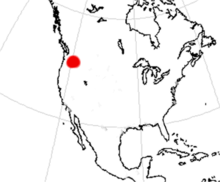Rhizocyon
| Rhizocyon Temporal range: early Oligocene | |
|---|---|
| Scientific classification | |
| Kingdom: | Animalia |
| Phylum: | Chordata |
| Class: | Mammalia |
| Order: | Carnivora |
| Family: | Canidae |
| Subfamily: | †Borophaginae |
| Genus: | †Rhizocyon Wang, Tedford, & Taylor, 1999 |
| Species: | †R. oregonensis |
| Binomial name | |
| Rhizocyon oregonensis (Merriam, 1906) | |
 | |
| Range of Rhizocyon based on fossil distribution | |
Rhizocyon ("root dog") is an early member of the subfamily Borophaginae, an extinct subgroup of canids that were endemic to western North America during the Whitneyan and Arikareean stages) of the Oligocene epoch, living from ~33.3—20.6 Ma., existing for approximately 12.7 million years.
Rhizocyon was similar to a contemporary species, Archaeocyon leptodus, from the Great Plains, but it shows a few subtle differences in the structure of the skull and dentition that indicate that Rhizocyon may be close to the ancestry of later borophagines. Only a single species, R. oregonensis, is known and all fossils come from the John Day Formation in Oregon.
Morphology
Fossil specimens of two individuals' body mass were examined by Legendre and Roth.[1]
- Specimen 1: 1.51 kg (3.3 lb).
- Specimen 2: 1.57 kg (3.5 lb).
Fossil distribution
- Foree Site, John Day Formation, Wheeler County, Oregon ~30.8—20.6 Ma.
- Longview Ranch Airport, John Day Formation, [Wheeler County, Oregon ~30.8—20.6 Ma.
- North Blue Basin Site, John Day Formation, Grant County, Oregon ~33.3—30.8 Ma.
- Kimberly Member, John Day Formation, Grant County, Oregon ~30.8—20.6 Ma.
- Roundup Flat (aka South Haystack), Grant County, Oregon ~30.8—20.6 Ma.
Sister genera
Notes
- ↑ S. Legendre and C. Roth. 1988. Correlation of carnassial tooth size and body weight in recent carnivores (Mammalia). Historical Biology
References
- Wang, Xiaoming., R.H. Tedford, and B.E. Taylor. 1999. Phylogenetic systematics of the Borophaginae (Carnivora, Canidae). Bulletin of the American Museum of Natural History, 243:1-391.
This article is issued from
Wikipedia.
The text is licensed under Creative Commons - Attribution - Sharealike.
Additional terms may apply for the media files.